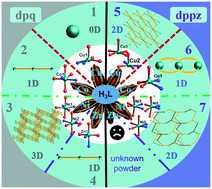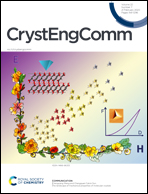Metal/N-donor-induced versatile structures and properties of seven 0D → 3D complexes based on dpq/dppz and O-bridged tricarboxylate: fluorescence and electrochemical behaviors†
Abstract
To investigate the effect of metal ions on the assembly of complexes derived from a semirigid tripodal carboxylic acid, 5-(4′-carboxylphenoxy) isophthalic acid (H3L), and two rigid chelating terminal N-donor ligands, dipyrazino[2,3-d:2′3′-f]quinoxaline (dpq) and dipyrido[3,2-a:2′,3′-c]phenazine (dppz), seven 0D → 3D complexes, [Cu(HL)(dpq)(H2O)2] (1), {[Co(HL)(dpq)(H2O)]·H2O}n (2), {[Ni3(L)2(dpq)3(H2O)4]·4H2O}n (3), {[Zn(HL)(dpq)(H2O)]·H2O}n (4), {[Cu2(L)(dppz)]·H2O}n (5), {[Co(HL)(dppz)]·H2O}n (6) and {[Ni3(L)2(dppz)3(H2O)3]}n (7), have been hydrothermally synthesized and structurally characterized by IR, TG and X-ray single-crystal diffraction analyses. Complex 1 is a 0D complex processing an unusual μ1-HL2− anion. Complex 2 features a 1D single chain based on Co(II) ions with a 6-coordinated mode. Complex 3 is the first (2,3,4)-connected 3D dpq-based framework derived from single/bimetallic mixed nodes with {83}2{84·122}{8} topology. Complex 4 is a 1D structure based on Zn(II) ions with a 5-coordinated mode. Complex 5 can be described as a 2D (6,3)-connected structure based on carboxyl-bridged Cu4 cores. Complex 6 is a 1D double chain derived from bimetallic nodes. Complex 7 exhibits a 2D double layer with (2,2,3,3,4)-connected nodes. The structural details of 1–7 were discussed. The solid-state luminescence properties of 1–7 and electrochemical properties of 1–3 have been investigated. The luminescence investigations show that 4 is an effective fluorescence probe for environmentally relevant Fe3+ ions. The electrochemical properties of a carbon paste electrode modified by the complexes 1–3 (1-CPE, 2-CPE and 3-CPE) were studied. 1-CPE has good electrocatalytic activity toward the reduction of nitrite, bromate and hydrogen peroxide in solution.



 Please wait while we load your content...
Please wait while we load your content...